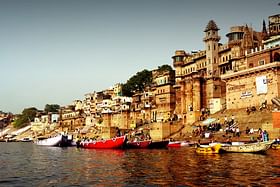Pilgrim paths are attracting more travellers than Goa beaches.
More than 60 per cent of tourism in India is associated with religious and spiritual tourism.
In recent years, travel in India has witnessed a significant transformation, with pilgrimage tourism emerging as a popular trend.
Holy sites across the country are now attracting devotees in unprecedented numbers. The surge is coming from both: devotees from all parts of India as well as devotees from across the globe.
Recently unveiled data for the year 2022 depicts a surge in religious tourism across major destinations in India.

The graph above shows that pilgrim paths are attracting more travellers than Goa’s beaches, which is generally regarded as the top choice for recreational travel for many tourists.
The popularity of pilgrim travel among all sections of the population is not unexpected. Some of the events associated with some temples even rank among the largest religious gatherings in the world.
The number of domestic tourists that visited places of pilgrimage was 1,433 million in 2022, while 6.64 million foreign tourists visited India. In 2021, the numbers stood at 677 million and 1.05 million, respectively.
More than 60 per cent of tourism in India is associated with religious and spiritual tourism.
Some of the other sites that receive thousands of daily worshippers include the Vaishno Devi shrine in Jammu, the Golden Temple in Amritsar, Tirumala’s Balaji temple in Andhra Pradesh.
The surging popularity of religious and spiritual sites as tourist destinations can be attributed to the significant improvements and thoughtful planning invested in recent years.
These sacred places have been curated to provide new and enriching features, elevating the overall experience for visitors. Additionally, the increased religious sentiments play a crucial role in attracting people from diverse backgrounds.
On the other hand, destinations like Goa, while still offering attractive amenities, have maintained a more consistent appeal over time.
Recognising The Significance Of Religious Sites In India
The focused efforts and development plans for these sacred sites have not only led to their growth but also fostered a widespread awareness of their religious and cultural significance.
The anticipation of proposed and further transformations has also kindled the interest of travellers from both domestic and international regions.
Recognising the substantial economic and cultural advantages that spiritual tourism can bestow upon the nation, Prime Minister Narendra Modi introduced initiatives like PRASAD (Pilgrimage Rejuvenation and Spiritual Augmentation Drive) in 2015.
These schemes have been aimed at enhancing and revitalising pilgrimage destinations, acknowledging their importance in attracting visitors and boosting the overall tourism industry.
Last year, the number of visitors to Kashi Vishwanath Dham in Varanasi soared to around seven crore after its renovation, a substantial increase from the approximately eighty lakh visitors the previous year.
The Sri Kashi Vishwanath Dham project was conceived with the vision of creating a convenient pathway to connect Sri Kashi Vishwanath Temple to the sacred banks of the River Ganga.
On 8 March 2019, the foundation stone of the project was laid by the Prime Minister.
Earlirt, the main temple, Kashi Vishwanath temple, located on the left bank of the river Ganga, was surrounded by narrow and cramped lanes.
Despite being a significant place of worship in the city, and the country, it struggled to accommodate the enormous crowds, which poured in throughout the year, especially during festive times.
On a typical day, around 3,000 to 5,000 people visited the temple, while on special occasions like Mahashivratri and Shravana masa, the numbers could surpass one to three lakh.
The project’s goal was to make the temple easily accessible to even the elderly and disabled, with the implementation of ramps, escalators, and other modern facilities.
Phase-1 of the project includes the inauguration of 23 buildings, intended to offer various amenities to the pilgrims visiting Sri Kashi Vishwanath Temple.
These facilities include Yatri Suvidha Kendra, Tourist Facilitation Centre, Vedic Kendra, Mumukshu Bhavan, Bhogshala, City Museum, Viewing Gallery, and Food Court, among others.
While the development of Kashi corridor has opened up doors to increasing visitors, it is worth noting that Mathura and Ayodhya, are still in process or early stages of development as per the aspirations for these sites.
Despite this, they are already witnessing a significant rise in tourist numbers each passing year.
Vrindavan and Ayodhya — Prominent Holy Destinations
For Vrindavan, Mathura, the vastly improved connectivity with surrounding regions has made it easily accessible to a broader audience.
The construction of the six-lane wide Yamuna Expressway has played a significant role in this transformation, providing a convenient route for an increased number of devotees, from Delhi NCR, to travel and visit the holy site for a day.
Similarly, the Agra Lucknow expressway and the emerging network of expressways across Uttar Pradesh state have further enhanced accessibility to Vrindavan.
With a focus to transform Ayodhya into a model temple town before the Shri Ram Janmabhoomi Temple opens its doors to devotees in 2024, the government has been focused on wide-scale development for the town — envisioned to become a prominent destination on the global religious map.
The current numbers of pilgrims are expected to increase on massive scale and for the same, the UP government, and the Ayodhya Development Authority (ADA) has been spearheading infrastructure and planning advancements in the city in order to cater to the anticipated surge and new opportunities — particularly in tourism and allied sectors.
The government is ensuring that the city is developed as a modern yet traditional and culturally rich, religious city.
Given the current policies and increasing awareness, it is poised to evolve into a well-structured, fully developed sector.
Numerous religious tourist routes or circuits have been identified and are continually being enhanced, recognising the growing importance of pilgrim tourism as an integral aspect of India’s tourism industry.


